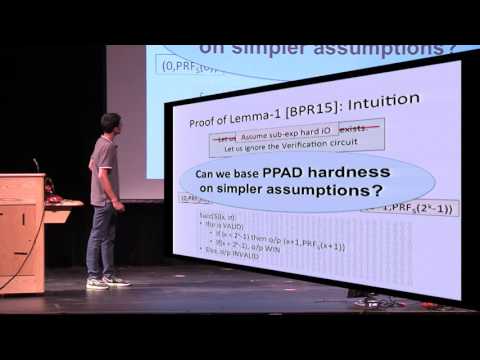Welcome to the resource topic for 2015/1078
Title:
Revisiting the Cryptographic Hardness of Finding a Nash Equilibrium
Authors: Sanjam Garg, Omkant Pandey, Akshayaram Srinivasan
Abstract:The exact hardness of computing a Nash equilibrium is a fundamental open question in algorithmic game theory. This problem is complete for the complexity class \ppad. It is well known that problems in \ppad\ cannot be \np-complete unless \np=\conp. Therefore, a natural direction is to reduce the hardness of \ppad\ to the hardness of problems used in cryptography. Bitansky, Paneth, and Rosen [FOCS 2015] prove the hardness of \ppad\ assuming the existence of quasi-polynomially hard indistinguishability obfuscation and sub-exponentially hard one-way functions. This leaves open the possibility of basing \ppad\ hardness on simpler, polynomially hard, computational assumptions. We make further progress in this direction and reduce \ppad\ hardness directly to polynomially hard assumptions. Our first result proves hardness of \ppad\ assuming the existence of {\em polynomially hard} indistinguishability obfuscation (\io) and one-way permutations. While this improves upon Bitansky et al.'s work, it does not give us a reduction to simpler, polynomially hard computational assumption because constructions of \io\ inherently seems to require assumptions with sub-exponential hardness. In contrast, {\em public key functional encryption} is a much simpler primitive and does not suffer from this drawback. Our second result shows that \ppad hardness can be based on {\em polynomially hard} compact public key functional encryption and one-way permutations. Our results further demonstrate the power of polynomially hard compact public key functional encryption which is believed to be weaker than indistinguishability obfuscation. Our techniques are general and we expect them to have various applications.
ePrint: https://eprint.iacr.org/2015/1078
Talk: https://www.youtube.com/watch?v=mxMMDY2q5MA
See all topics related to this paper.
Feel free to post resources that are related to this paper below.
Example resources include: implementations, explanation materials, talks, slides, links to previous discussions on other websites.
For more information, see the rules for Resource Topics .
